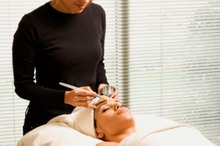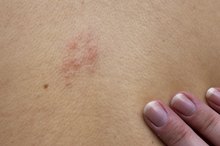What does fact checked mean?
At Healthfully, we strive to deliver objective content that is accurate and up-to-date. Our team periodically reviews articles in order to ensure content quality. The sources cited below consist of evidence from peer-reviewed journals, prominent medical organizations, academic associations, and government data.
The information contained on this site is for informational purposes only, and should not be used as a substitute for the advice of a professional health care provider. Please check with the appropriate physician regarding health questions and concerns. Although we strive to deliver accurate and up-to-date information, no guarantee to that effect is made.
Glycolic Acid vs. Retin-A
People commonly use chemical peels and retinoids to combat acne or improve their appearance after suffering skin damage caused by the sun. Retin-A is one of many vitamin A-based drugs called retinoids, and is a brand name for a drug called tretinoin. Glycolic acid is a natural acid that is found in sugar cane. It is used in chemical peels 3. Both glycolic acid and Retin-A cause the top layer of skin to peel off, generate new skin growth, unclog pores and remove dead skin cells.
Order
A glycolic acid peel is often applied following treatment with a retinoid such as Retin-A, according to the Mayo Clinic. The pre-treatment with Retin-A can last up to six weeks. This allows for better penetration with the chemical peel. Retin-A is often combined with oral antibiotics that kill acne bacteria.
- A glycolic acid peel is often applied following treatment with a retinoid such as Retin-A, according to the Mayo Clinic.
- The pre-treatment with Retin-A can last up to six weeks.
Home vs. Office
Retin-A Vs. Tazorac
Learn More
It is best to have a trained health professional administer glycolic acid, recommends the Mayo Clinic. Treatment lasts three to 20 minutes, and the patient is often given a sedative when treated. A patient undergoes four to six peels that are done one to two weeks apart. The peel removes a portion of the patient’s outer layer of skin. Retin-A is available with a doctor’s prescription, and the patient applies it at home each night, usually before bedtime, and washes it off in the morning. Retin-A also allows the top layer of skin to peel off, but it can take seven weeks to see effects, according to Baptist Health Systems in Jackson, Miss 2.
- It is best to have a trained health professional administer glycolic acid, recommends the Mayo Clinic.
- Retin-A also allows the top layer of skin to peel off, but it can take seven weeks to see effects, according to Baptist Health Systems in Jackson, Miss 2.
Identification
Retin-A is the most commonly used retinoid used in skin care, according to Harvard Medical School. Glycolic acid is among the mildest acids that are used to do chemical peels. Mild acids are used for peels classified as “superficial” as opposed to “medium” or “deep.”
Wrinkles
How to Use Moisturizer With Retin-A
Learn More
Both Retin-A and glycolic acid can be used to treat fine wrinkles, hyperpigmentation and brown spots. Glycolic acid is also commonly used to reduce appearance of acne scars. With Retin-A, improvements in the appearance of photodamage can be seen after three to six months of regular use, and best results show up between six and 12 months. With glycolic acid, “maintenance” peels are recommended monthly to maintain results once these are achieved, according to the Mayo Clinic.
- Both Retin-A and glycolic acid can be used to treat fine wrinkles, hyperpigmentation and brown spots.
After Care
A glycolic acid peel will make skin pink for up to 24 hours while it heals. A person will experience a stinging sensation while the peel is being done, and must mist skin with water and use cold compresses and moisturizers following the procedure. A person who uses Retin-A must use moisturizers as well as sunscreen, as the drug makes the skin more sensitive to the sun.
Side Effects
Glycolic acid side effects can include:
- blisters
- temporary redness
- scaling
- skin color changes
- scarring
- infection
Retin-A side effects, aside from sun sensitivity, include
- severe dryness of the skin
- redness
- peeling
- skin color changes
- an initial acne flare-up that usually dissipates with further use
- according to the Mayo Clinic
Related Articles
References
- Mayo Clinic.com: Tretinoin (Topical Route)
- Baptist Health Systems: Acne
- MayoClinic.com: Chemical Peel Types
- National Institutes of Health PubChem. Glycolic acid. Updated February 1, 2020.
- Tang SC, Yang JH. Dual effects of alpha-hydroxy acids on the skin. Molecules. 2018;23(4):863. doi:10.3390/molecules23040863
- Fabbrocini G, Annunziata MC, D'Arco V, et al. Acne scars: pathogenesis, classification and treatment. Dermatol Res Pract. 2010;2010:893080. doi:10.1155/2010/893080
- U.S. Food and Drug Administration. Alpha hydroxy acids. Updated May 7, 2019.
- Al-Talib H, Al-Khateeb A, Hameed A, Murugaiah C. Efficacy and safety of superficial chemical peeling in treatment of active acne vulgaris. An Bras Dermatol. 2017;92(2):212–216. doi:10.1590/abd1806-4841.20175273
- Abels C, Reich H, Knie U, Werdier D, Lemmnitz G. Significant improvement in mild acne following a twice daily application for 6 weeks of an acidic cleansing product (pH 4). Journal of Cosmetic Dermatology. 2014;13(2):103-8. doi:0.1111/jocd.12086
- Kaminaka C, Uede M, Matsunaka H, Furukawa F, Yamomoto Y. Clinical evaluation of glycolic acid chemical peeling in patients with acne vulgaris: a randomized, double-blind, placebo-controlled, split-face comparative study. Dermatological Surgery. 2014;40(3):314-22. doi:10.1111/dsu.12417
- Sharad J. Glycolic acid peel therapy - a current review. Clinical Cosmetic and Investigational Dermatology. 2013;6:281-8. doi:10.2147/CCID.S34029
- Takenaka Y, Hayashi N, Takeda M, Ashikaga S, Kawashima M. Glycolic acid chemical peeling improves inflammatory acne eruptions through its inhibitory and bactericidal effects on Propionibacterium acnes. Journal of Dermatology. 2012;39(4):350-4. doi:10.1111/j.1346-8138.2011.01321.x
Writer Bio
Linda Tarr Kent is a reporter and editor with more than 20 years experience at Gannett Company Inc., The McClatchy Company, Sound Publishing Inc., Mach Publishing, MomFit The Movement and other companies. Her area of expertise is health and fitness. She is a Bosu fitness and stand-up paddle surfing instructor. Kent holds a bachelor's degree in journalism from Washington State University.









